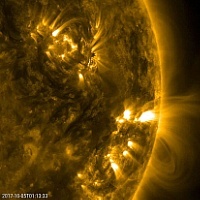30.05.2019
One of the big questions in solar physics is why the Sun’s activity follows a regular cycle of 11 years. Researchers from the Helmholtz-Zentrum Dresden-Rossendorf (HZDR), an independent German research institute, now present new findings, indicating that the tidal forces of Venus, Earth and Jupiter influence the solar magnetic field, thus governing the solar cycle. The team of researchers present their findings in the journal Solar Physics (doi: 10.1007/s11207-019-1447-1).

In principle, it is not unusual for the magnetic activity of a star like the Sun to undergo cyclic oscillation. And yet past models have been unable to adequately explain the very regular cycle of the sun. The HZDR research team has now succeeded in demonstrating that the planetary tidal forces on the Sun act like an outer clock, and are the decisive factor behind its steady rhythm. To accomplish this result, the scientists systematically compared historical observations of solar activity from the last thousand years with planetary constellations, statistically proving that the two phenomena are linked. “There is an astonishingly high level of concordance: what we see is complete parallelism with the planets over the course of 90 cycles,” enthused Frank Stefani, lead author of the study. “Everything points to a clocked process.”
As with the gravitational pull of the Moon causing tides on Earth, planets are able to displace the hot plasma on the Sun’s surface. Tidal forces are strongest when there is maximum Venus-Earth-Jupiter alignment; a constellation that occurs every 11.07 years. But the effect is too weak to significantly perturb the flow in the solar interior, which is why the temporal coincidence was long neglected. However, the HZDR researchers then found evidence of a potential indirect mechanism that may be able to influence the solar magnetic field via tidal forces: oscillations in the Tayler instability, a physical effect that, from a certain current, can change the behavior of a conductive liquid or of a plasma. Building on this concept, the scientists developed their first model in 2016; they have since advanced this model in their new study to present a more realistic scenario.
Small trigger with a major impact: tides utilize instability
In the hot plasma of the Sun, the Tayler instability perturbs the flux and the magnetic field, itself reacting very sensitively to tiny forces. A small thrust of energy is enough for the perturbations to oscillate between right-handed and left-handed helicity (the projection of the spin onto the direction of momentum). The momentum required for this may be induced by planetary tidal forces every eleven years – ultimately also setting the rhythm at which the magnetic field reverses the polarity of the Sun.
“When I first read about ideas linking the solar dynamo to planets, I was very skeptical,” Stefani recalled. “But when we discovered the current-driven Tayler instability undergoing helicity oscillations in our computer simulations, I asked myself: What would happen if the plasma was impacted on by a small, tidal-like perturbation? The result was phenomenal. The oscillation was really excited and became synchronized with the timing of the external perturbation.”
Solar dynamo with an added touch
In the standard scenario of a dynamo, the rotation of the Sun and the complex motion of the solar plasma create a cyclically changing magnetic field. Two effects interact here: the plasma rotates more quickly at the Sun’s equator than at the poles. This leads to the omega effect: the magnetic field lines frozen in the plasma stretch around the Sun and convert the magnetic field into a field aligned almost parallel to the Sun’s equator. The alpha effect describes a mechanism that twists magnetic field lines, forcing the magnetic field back into a north-south direction.
What exactly causes the alpha effect, however, is a subject of dispute. Stefani’s model indicates that the Tayler instability is partly responsible for this. The researchers consider the most plausible scenario to be one in which a classic solar dynamo is combined with the modulations excited by the planets. “Then the Sun would be a completely ordinary, older star whose dynamo cycle, however, is synchronized by the tides,” summarized Stefani. “The great thing about our new model is that we are now easily able to explain effects that were previously difficult to model, such as ‘false’ helicities, as observed with sunspots, or the well-known double peak in the Sun’s activity curve.”
Besides influencing the 11-year cycle, planetary tidal forces may also have other effects on the Sun. For example, it is also conceivable that they change the stratification of the plasma in the transition region between the interior radiative zone and the outer convection zone of the Sun (the tachocline) in such a way that the magnetic flux can be conducted more easily. Under those conditions, the magnitude of activity cycles could also be changed, as was once the case with the Maunder Minimum, when there was a strong decline in solar activity for a longer phase.
In the long term, a more precise model of the solar dynamo would help scientists to quantify climate-relevant processes such as space weather more effectively, and perhaps even to improve climate predictions one day. The new model calculations also mean that, besides tidal forces, potentially other, hitherto neglected mechanisms would have to be integrated into the solar dynamo theory, mechanisms with weak forces that can nevertheless – as researchers now know – have a major impact. To be able to investigate this fundamental question in the laboratory, too, the researchers are currently setting up a new liquid metal experiment at HZDR.
Quelle: The Institutes of the Helmholtz-Zentrum
